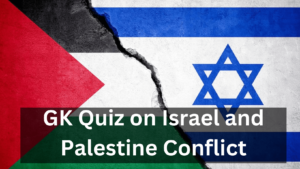GK Quiz on Israel and Palestine Conflict. Explore the historical background, current issues, and ongoing conflicts in the Israel and Palestine war. Learn about key events, the two-state solution, and the complex geopolitical landscape in the region.

GK Quiz on Israel and Palestine Conflict
Certainly! Here are 30 quiz questions with answers and explanations about the Israel and Palestine conflict:
1. When did the Israel and Palestine conflict begin?
a) 1948
b) 1967
c) 1993
d) 2005
2. What is the main cause of the Israel and Palestine conflict?
a) Religious differences
b) Political disputes
c) Ethnic tensions
d) Historical land claims
3. Which major international body partitioned Palestine in 1947, leading to the establishment of Israel?
a) United Nations
b) European Union
c) Arab League
d) NATO
4. What is the capital of Israel?
a) Tel Aviv
b) Jerusalem
c) Haifa
d) Gaza City
5. Which political and military organization represents the Palestinian people?
a) Fatah
b) Hamas
c) PLO
d) Al-Qaeda
6. What is the status of the city of Jerusalem in the Israel-Palestine conflict?
a) Jerusalem is entirely in Israeli control.
b) Jerusalem is entirely in Palestinian control.
c) Jerusalem is a shared city with disputed control.
d) Jerusalem has no significance in the conflict.
7. The 1967 Six-Day War resulted in Israel gaining control of which territories?
a) West Bank, Gaza Strip, Golan Heights, and Sinai Peninsula
b) West Bank, Gaza Strip, Jordan, and Lebanon
c) Golan Heights, Sinai Peninsula, Gaza Strip, and West Bank
d) West Bank, Jerusalem, and Sinai Peninsula
8. What is the name of the security barrier constructed by Israel in the West Bank?
a) Great Wall of Israel
b) Jerusalem Wall
c) Gaza Barrier
d) West Bank Barrier
9. Which Arab-Israeli conflict led to the Camp David Accords in 1978?
a) Yom Kippur War
b) First Intifada
c) Lebanon War
d) Six-Day War
10. What is the term commonly used to describe the Palestinian uprising against Israeli occupation?
a) Arab Spring
b) Oslo Accords
c) Intifada
d) Quartet Initiative
11. Which country was the first to recognize the State of Israel in 1948?
a) United States
b) United Kingdom
c) France
d) Russia
12. What is the primary goal of the BDS (Boycott, Divestment, Sanctions) movement related to Israel?
a) To support Israeli businesses
b) To promote cultural exchanges
c) To pressure Israel to change its policies toward Palestine
d) To enhance economic cooperation with Israel
13. Which neighboring country of Israel has a peace treaty with Israel since 1979?
a) Lebanon
b) Jordan
c) Egypt
d) Syria
14. The Balfour Declaration of 1917 expressed support for the establishment of a Jewish homeland in which region?
a) Palestine
b) Jordan
c) Syria
d) Lebanon
15. Which Palestinian political party currently governs the Gaza Strip?
a) Fatah
b) Hamas
c) PLO
d) Al-Qaeda
16. Which event is known as the “Nakba” in Palestinian history?
a) The signing of the Oslo Accords
b) The Six-Day War
c) The 1948 Arab-Israeli War
d) The Camp David Accords
17. What is the primary aim of the Oslo Accords signed in 1993?
a) Establish a Palestinian state
b) Create a single, unified Israeli-Palestinian government
c) Provide humanitarian aid to Palestinians
d) Promote economic cooperation between Israel and Palestine
18. Which country’s capital was moved to Jerusalem in 2018, a move that was widely criticized?
a) United States
b) United Kingdom
c) Russia
d) China
19. What is the “right of return” in the context of the Israel-Palestine conflict?
a) The right of Israelis to return to their homeland
b) The right of Palestinians to return to their pre-1948 homes
c) The right of Palestinians to Israeli citizenship
d) The right of Israelis to access the West Bank
20. Which U.S. president brokered the Camp David Accords in 1978?
a) Jimmy Carter
b) Ronald Reagan
c) Richard Nixon
d) Bill Clinton
21. The Golan Heights, a region of strategic importance, is a disputed territory between Israel and which country?
a) Lebanon
b) Jordan
c) Syria
d) Egypt
22. What is the “Two-State Solution” in the context of the Israel-Palestine conflict?
a) The establishment of a single, unified state for both Israelis and Palestinians
b) The creation of separate Israeli and Palestinian states living side by side
c) The complete withdrawal of Israeli forces from the West Bank
d) The division of Israel into two separate states
23. What is the primary reason for the ongoing blockade of the Gaza Strip by Israel?
a) To prevent terrorist attacks
b) To control the flow of goods and services
c) To maintain a military presence
d) To encourage economic development
24. Which United Nations agency provides assistance to Palestinian refugees?
a) UNICEF
b) UNHCR
c) UNRWA
d) UNESCO
25. What was the outcome of the Oslo Accords for the Palestinian territories?
a) Full Palestinian statehood
b) Limited self-governance in parts of the West Bank and Gaza Strip
c) Annexation by Israel
d) Complete withdrawal of Israeli forces
26. Which group, considered a terrorist organization by some countries, governs the West Bank?
a) Fatah
b) PLO
c) Hamas
d) Hezbollah
27. What is the status of the city of Hebron in the Israel-Palestine conflict?
a) Controlled by Israel
b) Controlled by Palestine
c) Divided into Israeli and Palestinian zones
d) A neutral international city
28. Which U.S. president formally recognized Jerusalem as Israel’s capital in 2017?
a) Barack Obama
b) George W. Bush
c) Donald Trump
d) Joe Biden
29. What is the Green Line in the context of the Israel-Palestine conflict?
a) A demilitarized zone
b) The pre-1967 border between Israel and the West Bank
c) A zone of environmental protection
d) A dividing line between Israeli and Palestinian territories
30. Which international organization granted non-member observer status to Palestine in 2012?
a) United Nations
b) European Union
c) Arab League
d) Organization of American States
These questions cover various aspects of the Israel and Palestine conflict, providing a comprehensive overview of the key events, issues, and players involved.
















